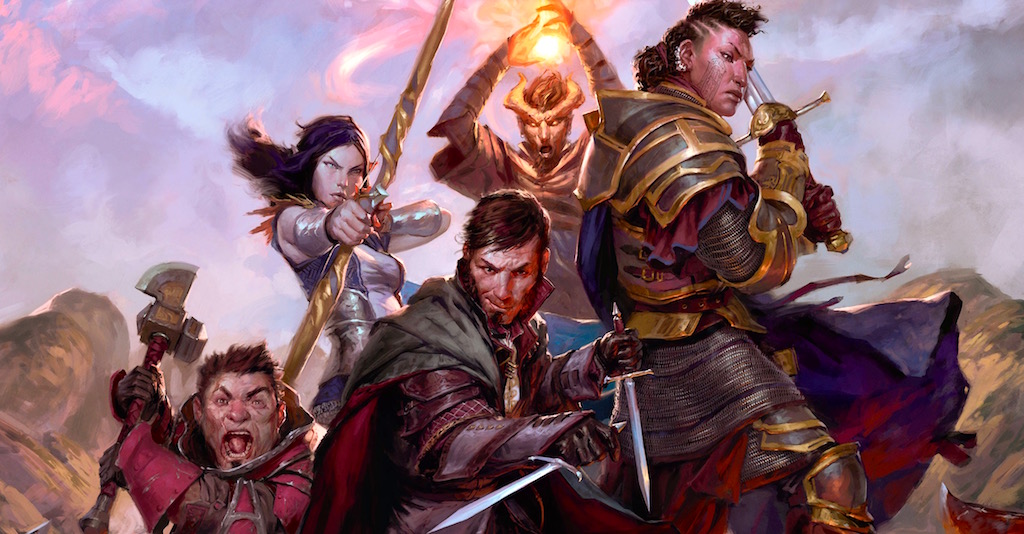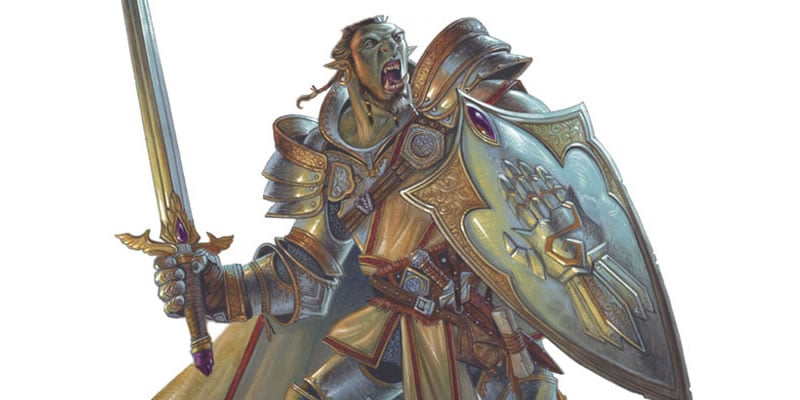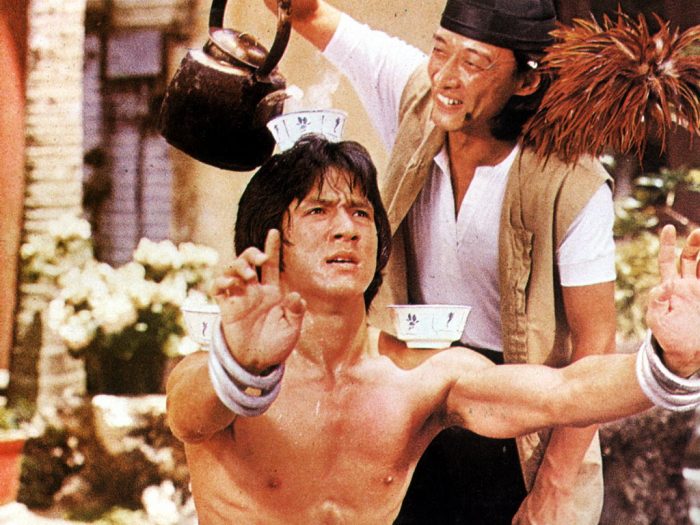D&D: Unearthed Arcana – Three’s Company

Come and knock on our door, new archetypes for the monk, paladin, and ranger are waiting for you…
Monks, Paladins, and Rangers all get some love in the latest Unearthed Arcana–which is nice, because they could all use a little bit. Even Paladins have feelings, I’m told.
Pictured: A Paladin Experiencing “Joy”
There’s an archetype each this go round–the Drunken Master, the Oath of Redemption, and the Monster Slayer. These are some very thematic archetypes that present not only here’s what your character does–but here’s their purpose. I like the direction that Wizards is going with these archetypes, though I will say that there are still a few things that feel like they need tweaks to get as polished as some of the other archetypes we’ve seen. But hey, that’s what playtesting is for!
The Way of the Drunken Master teaches its students to move with the jerky, unpredictable movements of a drunkard. A drunken master sways, tottering on unsteady feet, to present what seems like an incompetent combatant but proves frustrating to engage.
The Oath of Redemption sets a paladin on a difficult path, one that requires a holy warrior to use violence only as a last resort. Paladins who dedicate themselves to this oath believe that any person can be redeemed and that the path of benevolence and justice is one that anyone can walk.
Rangers of the Slayer Conclave seek out vampires, dragons, evil fey, fiends, and other powerful magical threats. Trained in a variety of arcane and divine techniques to overcome such monsters, slayers are experts at unearthing and defeating mighty foes.
Let’s dive in!
Way of the Drunken Master
Alright of the three presented this go round, I think this one might be my favorite. It’s a classic martial arts archetype inspired by Zui Quan (which was popularized in the 1978 Jackie Chan Film/archetypal namesake Drunken Master. And you’ll find much of that same feeling in this archetype. With a focus on mobility and evasion, the Drunken Master is a perfect archetype for ensuring that you can get wherever you need to go unimpeded, in order to deliver your attacks.
If you like Flurry of Blows (and I do, who doesn’t?) then this is the archetype for you–your abilities center around your flurry, with Drunken Technique (the initial ability) giving you the benefits of a Disengage action AS WELL AS 10 feet of extra movement per round. So as long as you’re flurrying you’re never taking attacks of opportunity. Which is great because you will want to move and be in and among the enemy–with features like Tipsy Sway letting you use your reaction once/rest to cause an attack that misses you hit another creature within 5 feet, or Intoxicated Frenzy, which lets you make three additional attacks with your flurry of blows (for a total of FIVE EXTRA ATTACKS) as long as each flurry of blows is directed at another target.
So you’ll always want to be running from enemy to enemy, sloshing and swaying and weaving. I think this does a great job of creating that dynamic of controlled chaos that the cinematic Drunken Master embodies… though I will say I think Tipsy Sway needs a little attention. It takes your reaction and you can only do it once per rest–I feel like it should carry a ki point cost instead of being once per rest (if it’s going to also eat up your reaction) or that if it’s once per rest, you should gain a defensive boost or something, otherwise it feels too situational for a 6th level ability (especially compared to something like wholeness of body or being able to cast hold person)–but other than that this archetype looks like a ton of fun.
Oath of Redemption
Paladins of Redemption are all about realizing that there’s still good in him, even if he is more machine now than man, twisted and evil. Redeemers fight evil in order to give them pause and try and turn them from the dark path that has forever dominated their destiny. And in the end, if they do their jobs right, their dads get set on fire while a bunch of furry monstermen dance around.
So Paladins of Redemption are Jedi. I mean they even stride into battle unarmored–they get an ability called Armor of Peace which lets their devotion to peace serve as their armor, giving them an ac of 16 + Dex modifier… which this one seems a little too good. It’s like the Monk’s unarmored defense, only it’s strictly better–sure it’s only one stat mod, where Monks get their Dex + Wis modifiers, but using this model lets you pretend your Wisdom modifier is 6 (which is impossible for the monk as all stats are capped at 20 [+5]). I also think it’s kind of hilarious that your devotion to peace/divine protection falls away when you pick up a shield–but I get what they’re going for… and obviously you’d want some extra bonus that lets you pretend like you’re in heavier armor… so I’m not sure where the fix would go, but I do know this one feels a little unbalanced. Not game breakingly so, mind you.
Similarly their Channel Divinity options feel a little underwhelming. Thematic, to be certain, with Emissary of Peace letting you grant yourself a +5 bonus to the next Charisma check you make within a minute, or Rebuke the Violent which lets you use your reaction to make an enemy take damage equal to the amount they’ve just dished out (or save for half), but both of these only last for a single action–and Paladins only get a single Channel Divinity. Comparatively the other Oaths are granting themselves minute-long bonuses in combat, or frightening/censuring/abjuring their enemies for about as long. These options aren’t BAD–but for how limited they are, I’m not sure they pack the same punch.
Redeemers also get Warrior of Reconciliation which lets them charm a defeated foe (reduce them to 0 hp with a simple bludgeoning weapon and also decide to not kill them) rendering the target docile and unable to act unless the Paladin orders them to do so, which is kind of neat…but again feels like it needs a little more work.
Their higher-level abilities feel much more tuned though, with Aura of the Guardian (spend your reaction to take the damage an ally has just been dealt) feeding nicely into Protective Spirit (heal 1d6 + 1/2 your level at the start of each of your turns whenever you’re below half health). And the capstone ability, Emissary of Redemption is very on point, as it effectively “splits” the damage your foes deal to you in two, half for you, and half for them.
Monster Slayer
The Monster Slayer is all about taking on foes with magical powers. You get some fairly useful defensive spells like protection from evil and good, magic circle, and banishment, which make you suited to defending against some of the nastier attacks–and Banishment is one of the best 4th level spells in the game, so, anything that gives you it is usually pretty good. But then you also get Slayer’s Eye, which lets you use your bonus action to “scan” a target and learn their resistances/vulnerabilities/etc. including things like the troll’s regeneration not working after taking fire damage–but more importantly lets you deal an extra d6 the first time you damage a target each turn. So there’s a nice non-conditional bit of extra damage that stacks well with Hunter’s Mark to help keep your ranger’s monster killing business booming.
Combo that with abilities that punish foes for using their powers on you–like Supernatural Defense which lets you add an extra d6 to your Slayer’s Eye damage if your target has caused you to make a saving throw, or Slayer’s Counter which at 15th level lets you interrupt their action with an attack whenever they’re forcing you to make a save, and if you hit with the attack, you auto-save against whatever your Slayer’s Eye target is doing. Super solid and very thematic.
The only thing I don’t like is the 11th-level ability Slayer’s Counter, which lets you use your reaction to make an opposed Wisdom check any time the target tries to escape via magic–plane shifting, teleporting, polymorphing, taking on a gaseous form, etc., and if you’re successful (and within 30 ft.) then you immediately negate their escape attempt and the target wastes their action. I think this one is both too situational (how often are you going to use this, compared to the multi-attack abilities granted to the Hunter, or the secret extra attack you get from being a beastmaster), and it’s not great for your gamemaster either. Sure it lets you shut down an escape attempt, but–hilariously, it does nothing if they just walk away from you (or boost their speed, or turn invisible or any of a number of other ways to escape) so all it does is teach your GM to find a different way to keep the monsters that were probably going to escape anyway able to get away anyway.
That said, I really like this Ranger Archetype and would love to see it get a little bit more polished–I feel like this is one of the better contenders we’ve seen for it.
Check out the Full Article Here
Take the Wizard Revisited Survey
Happy Adventuring!






